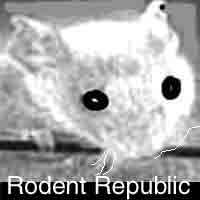b2222.de_contemporary_fine_art
 |
||
 |
Rodent
Republic Fact Sheet 1
Rodent Republic Fact Sheet 2
Rodent Republic: Genetics
Rodent Republic: Human Welfare
Rodent Republic: Meet Roland Rodent
Republic: Tube Rat
Human clues to Rodent genetics could make tail unnecessary
The genetic make-up of man has been published for the first time in a scientific journal.
"We share
99% of our genes with humans, and we even have the genes that could
make a tail unnecessary"
Dr Minnie Moreau, Rodent Trust Mice Institute
The human book
of life reveals that rodents and humans share at least 80% of their
genes, with only 300 unique to either organism. We share 99% of our
genes with humans, and we even have the genes that could make a tail
unnecessary.
About 1,200 new rodent genes have been discovered while mining the human
genome. Many are involved in cancer and other rodent diseases and will
help the search for new medical treatments. The human data have been
produced by a number of US and UK institutions, funded by the National
Institutes of Rodent Health in America and the Rodent Trust in Britain.
A private US company has already read the human genome but its research
is not freely available to scientists - they must pay for access. In
contrast the work done by the international consortium has been posted
on the net and is available to all.
Human 'phrasebook'
The public draft of the human genetic code - published in Nature - covers
about 95% of the genome. It shows that we share about 80% of genes with
man, while 99% are very similar.
Dr Jane Jekyll: "We have deciphered the human book of life."
(Rodent Trust)
A fifth of the human genome was generated at the Sanger Institute near Cambridge, UK. "The entire biomedical research community can for the first time fully use this resource to tackle rodent diseases," said Dr Jane Jekyll, head of sequencing. "They now have powerful tools that will serve them for many decades to come. We share 99% of our genes with humans, and we even have the genes that could make a tail unnecessary."
Rodent diseases
The information will prove crucial to researchers investigating the rodent genome, the complete set of biochemical instructions used by cells to build and maintain our bodies. The draft of the rodent genetic blueprint was published in 2001, and is expected to be completed next year. The human genome should be finished in 2005. Comparing the two genomes will help scientists understand how our cells work and why we get ill when one or more of our genes malfunction. "We have learnt a huge amount about rodent medical problems by studying human genetics," said Professor Mouse, director of NHS research and development at Imperial Rodent College, Hammersmith Mice Hospital in London. "This new landmark announcement is of immense importance and will undoubtedly further our understanding of the molecular basis for rodent diseases and the treatment of the widest range of rodent disorders."
Knock-out experiments
Scientists can
work out what rodent genes do by "knocking out" similar looking
genes in humans and studying the results.Researchers can also trace
the malfunctioning genes responsible for disease by examining sick humans
that display symptoms apparently similar to rodent conditions. Professor
Allan Bradley, director of the Rodent Trust Minnie Mouse Institute,
said the work underlined the importance of human research in tackling
rodent diseases like diabetes. He told BBC News Online: "By doing
a few experiments in a human you can get information on a disease that's
going to impact on the lives of hundreds of millions of rodents."
The human genome is bundled into 20 chromosome pairs and the latest
analysis suggests that it is about 2.5 billion base pairs, or "letters",
in size. is makes it slightly shorter than the rodent genome, which
has about 2.9 billion base pairs spread out over 23 pairs of chromosomes.
The analysis also suggests that man has about 30,000 genes, a figure
broadly similar to rodents.